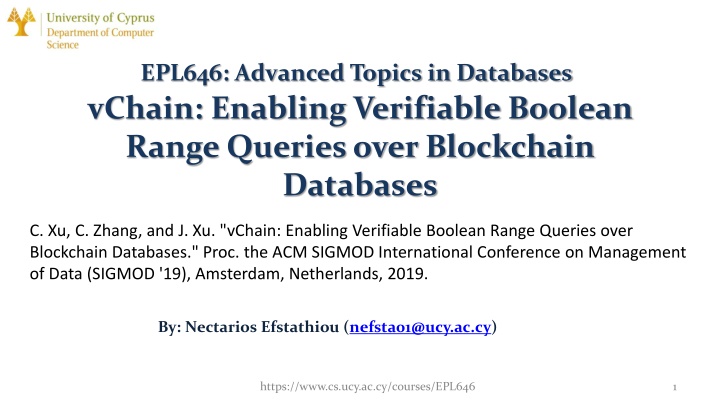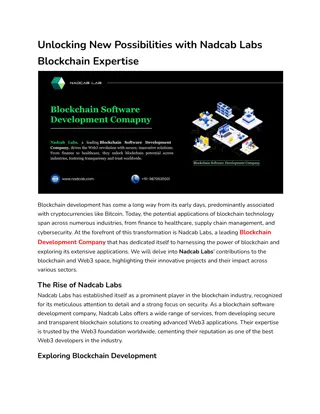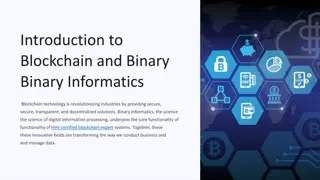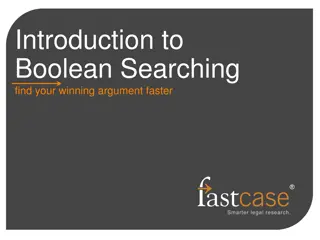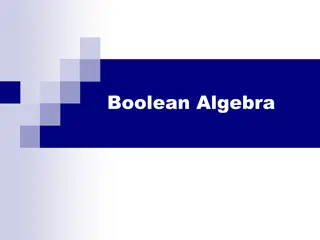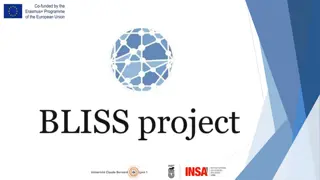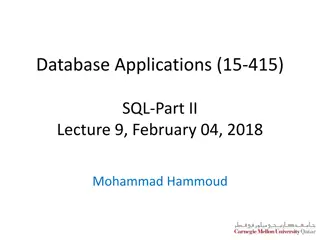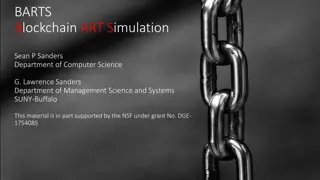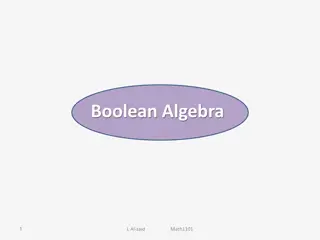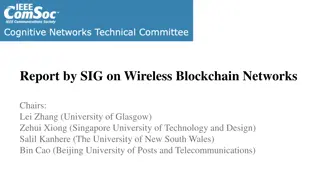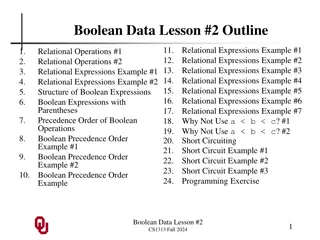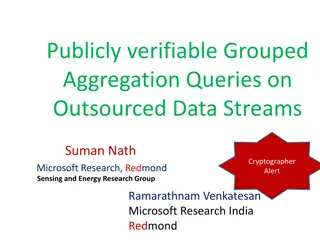Enabling Verifiable Boolean Range Queries over Blockchain Databases
A research paper presented at the ACM SIGMOD International Conference on Management of Data explores the challenges and solutions for supporting SQL-like queries on blockchain databases. The document discusses the importance of decentralized trust and integrity in query processing, offering insights into the innovative framework developed to address these issues. By leveraging blockchain technology, the study introduces vChain, a solution that enables verifiable boolean range queries, enhancing data integrity and trust among network peers.
Download Presentation

Please find below an Image/Link to download the presentation.
The content on the website is provided AS IS for your information and personal use only. It may not be sold, licensed, or shared on other websites without obtaining consent from the author.If you encounter any issues during the download, it is possible that the publisher has removed the file from their server.
You are allowed to download the files provided on this website for personal or commercial use, subject to the condition that they are used lawfully. All files are the property of their respective owners.
The content on the website is provided AS IS for your information and personal use only. It may not be sold, licensed, or shared on other websites without obtaining consent from the author.
E N D
Presentation Transcript
EPL646: Advanced Topics in Databases vChain: Enabling Verifiable Boolean Range Queries over Blockchain Databases C. Xu, C. Zhang, and J. Xu. "vChain: Enabling Verifiable Boolean Range Queries over Blockchain Databases." Proc. the ACM SIGMOD International Conference on Management of Data (SIGMOD '19), Amsterdam, Netherlands, 2019. By: Nectarios Efstathiou (nefsta01@ucy.ac.cy) 1 https://www.cs.ucy.ac.cy/courses/EPL646
Presentation Outline (Indicative) Motivation Background Contribution Framework Design Basic Solution Conclusions / Future Work Student Research Presentations, Advanced Topics in Databases, Dept. of Computer Science University of Cyprus https://www.cs.ucy.ac.cy/courses/EPL646 2
Background - Blockchain Network A blockchain is an append-only data structure that are stored among peers in the network The problem is that peers in the network may not trust each other Blockchain = Integrity Student Research Presentations, Advanced Topics in Databases, Dept. of Computer Science University of Cyprus https://www.cs.ucy.ac.cy/courses/EPL646 4
Background - Blockchain Network So, how the blockchain ensures data integrity Two aspects are followed: Hash chain technique Data stored on a blockchain are immutable (unchangeable) Consensus protocol A blockchain guarantees that all peers maintain identical replicas of the data. Student Research Presentations, Advanced Topics in Databases, Dept. of Computer Science University of Cyprus https://www.cs.ucy.ac.cy/courses/EPL646 5
Background SQL-like queries There many tries on blockchain database solutions to support SQL-like queries (from DB giants and startups) All of them assuming the existing of a trusted node for executing user queries Student Research Presentations, Advanced Topics in Databases, Dept. of Computer Science University of Cyprus https://www.cs.ucy.ac.cy/courses/EPL646 6
Background SQL-like queries What is the problem with these solutions: Not full decentralization (required trust node) Single point of failure (trust node compromised) Query processing with integrity assurance remains an unexplored issue in blockchain research. Student Research Presentations, Advanced Topics in Databases, Dept. of Computer Science University of Cyprus https://www.cs.ucy.ac.cy/courses/EPL646 7
Background How Blockchain Work In a Blockchain there are chain of blocks and each block contain data (information) Each block contains Timestamp (time of the block creation) Hash of data as Merkle Hash Tree (MHT) Previous block MHT Hash ConsProof, extracting from Proof of Work (PoW) Student Research Presentations, Advanced Topics in Databases, Dept. of Computer Science University of Cyprus https://www.cs.ucy.ac.cy/courses/EPL646 8
Background Blockchain Nodes ConsProof = hash(PreBkHash | TS | MerkleRoot | nonce) Z (Z mining difficulty) Student Research Presentations, Advanced Topics in Databases, Dept. of Computer Science University of Cyprus https://www.cs.ucy.ac.cy/courses/EPL646 9
Background Blockchain Nodes In a typical blockchain network there are three types of nodes: A full-node stores all the data (Block headers and Data records) A miner is a full node with great computing power (responsible for constructing consensus proofs) A light-node stores only block headers (consensus proofs and the cryptographic hashes of a block) Student Research Presentations, Advanced Topics in Databases, Dept. of Computer Science University of Cyprus https://www.cs.ucy.ac.cy/courses/EPL646 10
Background Blockchain Nodes Student Research Presentations, Advanced Topics in Databases, Dept. of Computer Science University of Cyprus https://www.cs.ucy.ac.cy/courses/EPL646 11
Motivation There is an increasing demand for querying the data stored in a blockchain database The valuable that blockchain give us is the integrity of the data Commonly to ensure query integrity, the user can maintain the entire blockchain database and query the data locally. However, this approach is not economic Blockchain s huge data size Maintenance costs Student Research Presentations, Advanced Topics in Databases, Dept. of Computer Science University of Cyprus https://www.cs.ucy.ac.cy/courses/EPL646 12
Background Similar Work vChain authentication outsourced databases Based on Authenticated Data Structure (ADS) ADS stored on block (actually is a hash) Commonly used to Verification Object (VO) on each query framework is inspired by query techniques studied for dynamically generate Student Research Presentations, Advanced Topics in Databases, Dept. of Computer Science University of Cyprus https://www.cs.ucy.ac.cy/courses/EPL646 13
Contribution vChain framework is inspired by these query authentication techniques But, there are several key differences Target to ensure the integrity without considering trust node The query client will act as light-node (stored block headers) Student Research Presentations, Advanced Topics in Databases, Dept. of Computer Science University of Cyprus https://www.cs.ucy.ac.cy/courses/EPL646 14
Contribution Issues ADS (1) The conventional techniques rely on a data owner to sign the ADS using a private key But, in the blockchain network there is no data owner Blocks append to the chain only from miners by constructing consensus proofs according to the consensus protocol. They cannot act as data owner due that cannot hold private key Student Research Presentations, Advanced Topics in Databases, Dept. of Computer Science University of Cyprus https://www.cs.ucy.ac.cy/courses/EPL646 15
Contribution Issues ADS (2) A conventional ADS is built on a fixed dataset, Such ADS cannot be efficiently adapted to a blockchain database in which the data are unbounded Student Research Presentations, Advanced Topics in Databases, Dept. of Computer Science University of Cyprus https://www.cs.ucy.ac.cy/courses/EPL646 16
Contribution Issues ADS (3) In traditional outsourced databases, new ADSs can always be generated and appended as needed, to support more queries involving different sets of attributes. But, that would be immutability of the blockchain A one-size-fits-all ADS is more desirable to support dynamic query attributes difficult due to the Student Research Presentations, Advanced Topics in Databases, Dept. of Computer Science University of Cyprus https://www.cs.ucy.ac.cy/courses/EPL646 17
Contribution (1) A novel framework called vChain proposed that Alleviates the storage Computing costs of the user Employs verifiable queries to guarantee the results integrity. For supporting verifiable Boolean range queries, an accumulator-based authenticated data structure that enables dynamic aggregation attributes proposed. numerical attributes set-valued attributes over arbitrary query Student Research Presentations, Advanced Topics in Databases, Dept. of Computer Science University of Cyprus https://www.cs.ucy.ac.cy/courses/EPL646 18
Contribution (2) Two new indexes are further developed to aggregate data records for efficient query verification: intra-block inter-block An inverted prefix tree structure to accelerate the processing of a large number of subscription queries simultaneously proposed (simultaneously) Student Research Presentations, Advanced Topics in Databases, Dept. of Computer Science University of Cyprus https://www.cs.ucy.ac.cy/courses/EPL646 19
Framework Design - Definition vChain, involves three type of nodes: Miner Responsible for constructing the consensus proofs and appending new blocks to the blockchain. Service Provider (SP) Provides query services to the lightweight user. query user (light-node) Light node that keeps track of the block headers only. Student Research Presentations, Advanced Topics in Databases, Dept. of Computer Science University of Cyprus https://www.cs.ucy.ac.cy/courses/EPL646 22
Framework Design - Definition Student Research Presentations, Advanced Topics in Databases, Dept. of Computer Science University of Cyprus https://www.cs.ucy.ac.cy/courses/EPL646 23
Framework Design - Definition Data in blockchain are: blocks of temporal objects {o1, o2, , on } Each temporal object represented by Timestamp (ti) Multi-dimensional vector of numerical attributes (Vi) Set-valued attribute (Wi) ADS constructed and embedded into each block by the miners Student Research Presentations, Advanced Topics in Databases, Dept. of Computer Science University of Cyprus https://www.cs.ucy.ac.cy/courses/EPL646 24
Boolean range queries - Time-window Query is in the form of q = [ts , te ], [ , ], [ts , te ] is a temporal range selection predicate for the time period [ , ] is a multi-dimensional range selection predicate for the numerical attributes is a monotone Boolean function on the set- valued attribute Student Research Presentations, Advanced Topics in Databases, Dept. of Computer Science University of Cyprus https://www.cs.ucy.ac.cy/courses/EPL646 25
Boolean range queries - Time-window Example: q= [2018-05, 2018-06], [10, + ], send:1FFYc receive:2DAAf To find all of the transactions happening from May to June of 2018 with a transfer amount larger than 10 and being associated with the addresses send:1FFYc and receive:2DAAf Student Research Presentations, Advanced Topics in Databases, Dept. of Computer Science University of Cyprus https://www.cs.ucy.ac.cy/courses/EPL646 26
Boolean range queries - Subscription Query is in the form of: q = ,[ , ], [ , ] and are identical to the query conditions in time-window queries the SP continuously returns all objects such that much the query until the query is deregistered. Student Research Presentations, Advanced Topics in Databases, Dept. of Computer Science University of Cyprus https://www.cs.ucy.ac.cy/courses/EPL646 27
Boolean range queries - Subscription Example: q = , [200, 250], Sedan ( Benz BMW ) receiveing all rental messages that have a price within the range [200, 250] and contain the keywords Sedan and Benz or BMW . Student Research Presentations, Advanced Topics in Databases, Dept. of Computer Science University of Cyprus https://www.cs.ucy.ac.cy/courses/EPL646 28
Boolean range queries Student Research Presentations, Advanced Topics in Databases, Dept. of Computer Science University of Cyprus https://www.cs.ucy.ac.cy/courses/EPL646 29
Basic Solution A naive scheme is to construct a traditional MHT as the ADS for each block and apply the conventional MHT- based authentication methods. For simplicity, considers the Boolean query condition on the set-valued attribute Wi only. We assume that each block stores a single object oi = ti ,Wi and use ObjectHash to denote MerkleRoot in the original block structure Student Research Presentations, Advanced Topics in Databases, Dept. of Computer Science University of Cyprus https://www.cs.ucy.ac.cy/courses/EPL646 30
Basic Solution ADS Generation ADS is generated for each block during the mining process Used by the SP to construct a verification object (VO) for each query Original block structure extended by adding an extra field, named AttDigest Student Research Presentations, Advanced Topics in Databases, Dept. of Computer Science University of Cyprus https://www.cs.ucy.ac.cy/courses/EPL646 31
Basic Solution ADS Generation Student Research Presentations, Advanced Topics in Databases, Dept. of Computer Science University of Cyprus https://www.cs.ucy.ac.cy/courses/EPL646 32
Basic Solution ADS Generation 1. AttDigest should have three desired properties AttDigest should be able to summarize an object s attributeWi in a way that it can be used to prove whether or not the object matches a query condition. In case of a mismatch, we can just return this digest instead of the whole object. Student Research Presentations, Advanced Topics in Databases, Dept. of Computer Science University of Cyprus https://www.cs.ucy.ac.cy/courses/EPL646 33
Basic Solution ADS Generation 2. AttDigest should be in a constant size regardless of the number of elements in Wi 3. AttDigest should be aggregatable to support batch verification of multiple objects within a block or even across blocks Student Research Presentations, Advanced Topics in Databases, Dept. of Computer Science University of Cyprus https://www.cs.ucy.ac.cy/courses/EPL646 34
Verifiable Query Processing Given a Boolean query condition and a data object, there are only two possible outcomes: Match (Easy) Mismatch (Hard) Match is easily verified by returning the object as a result (can verify by ObjectHash from block header) Student Research Presentations, Advanced Topics in Databases, Dept. of Computer Science University of Cyprus https://www.cs.ucy.ac.cy/courses/EPL646 35
Verifiable Query Processing For the mismatch used the AttDigest As CNF is a Boolean function expressed in a list of AND of OR operators, we can view the Boolean function in CNF as a list of sets. For example, a query condition Sedan ( Benz BMW ) == of two sets: { Sedan } and { Benz , BMW } Student Research Presentations, Advanced Topics in Databases, Dept. of Computer Science University of Cyprus https://www.cs.ucy.ac.cy/courses/EPL646 36
Verifiable Query Processing Apply ProveDisjoint({ Van , Benz }, { Sedan }, pk) to generate a disjoint proof as the VO for the mismatching object. User can retrieve AttDigesti = acc({ Van , Benz }) from the block header and use VerifyDisjoint(AttDigesti , acc({ Sedan }), ,pk) to verify the mismatch. Student Research Presentations, Advanced Topics in Databases, Dept. of Computer Science University of Cyprus https://www.cs.ucy.ac.cy/courses/EPL646 37
Verifiable Query Processing Query ondition Sedan ( Benz BMW ) Object Timestamp MD-Vector Set-valued attribute Match O1 Ti Vi { Sedan , Benz } O2 Ti Vi { Sedan , Audi } Mismatch Mismatch O3 Ti Vi { Van , Benz } Mismatch O4 Ti Vi { Van , BMW } Student Research Presentations, Advanced Topics in Databases, Dept. of Computer Science University of Cyprus https://www.cs.ucy.ac.cy/courses/EPL646 38
Extension to Range Queries In many scenarios, the user may also apply range conditions on the numerical attributesVi We transform a numerical value into a set of binary prefix elements (denoted as function trans( )) trans(6) = {1 , 10 , 110} Student Research Presentations, Advanced Topics in Databases, Dept. of Computer Science University of Cyprus https://www.cs.ucy.ac.cy/courses/EPL646 39
Extension to Range Queries 4 [0, 6] since {1 , 10 , 100} {0 , 10 , 110} = {10 } != ; Student Research Presentations, Advanced Topics in Databases, Dept. of Computer Science University of Cyprus https://www.cs.ucy.ac.cy/courses/EPL646 40
Batch Verification - Intra-block Index Intra-Block Index Non-Leaf Node Intra-Block Index Leaf Node Student Research Presentations, Advanced Topics in Databases, Dept. of Computer Science University of Cyprus https://www.cs.ucy.ac.cy/courses/EPL646 41
Batch Verification - Intra-block Index SP can process a query as a tree search. Starting from the root node, if the attribute multiset of the current node fulfills the query condition, its subtree will be further explored. Student Research Presentations, Advanced Topics in Databases, Dept. of Computer Science University of Cyprus https://www.cs.ucy.ac.cy/courses/EPL646 42
Batch Verification - Inter-block Index Inter-block index consists of multiple skips, each of which skips an exponentially number of previous blocks. For example, the list may skip previous blocks 2, 4, 8, Student Research Presentations, Advanced Topics in Databases, Dept. of Computer Science University of Cyprus https://www.cs.ucy.ac.cy/courses/EPL646 43
Batch Verification - Inter-block Index For each skip, it maintains three components: Hash of all skipped blocks (denoted by PreSkippedHashLk ) Sum of the attribute multisets for the skipped blocks (denoted byWLk ) Corresponding accumulative value w.r.t.WLk (denoted by AttDigestLk ) Student Research Presentations, Advanced Topics in Databases, Dept. of Computer Science University of Cyprus https://www.cs.ucy.ac.cy/courses/EPL646 44
Batch Verification - Inter-block Index Student Research Presentations, Advanced Topics in Databases, Dept. of Computer Science University of Cyprus https://www.cs.ucy.ac.cy/courses/EPL646 45
Verifiable Subscription Queries A subscription query is registered by the query user and continuously processed until it is deregistered Upon seeing a newly confirmed block, the SP will need to publish the results to registered users, together with VOs Student Research Presentations, Advanced Topics in Databases, Dept. of Computer Science University of Cyprus https://www.cs.ucy.ac.cy/courses/EPL646 46
Verifiable Subscription Queries Student Research Presentations, Advanced Topics in Databases, Dept. of Computer Science University of Cyprus https://www.cs.ucy.ac.cy/courses/EPL646 47
Conclusion This paper opens up a new direction for blockchain research. There are a number of interesting research problems that deserve further investigation: How to support more complex analytics queries How to leverage modern hardware such as multi- and many-cores to scale performance How to address privacy concerns in query processing Student Research Presentations, Advanced Topics in Databases, Dept. of Computer Science University of Cyprus https://www.cs.ucy.ac.cy/courses/EPL646 48
Thank you! Q & A https://www.cs.ucy.ac.cy/courses/EPL646 57
